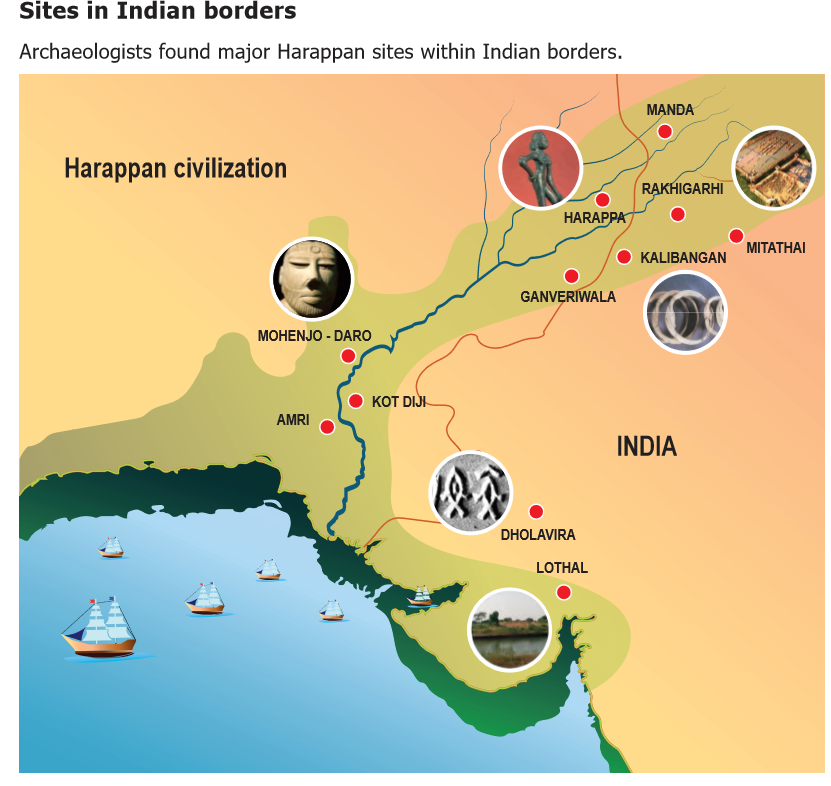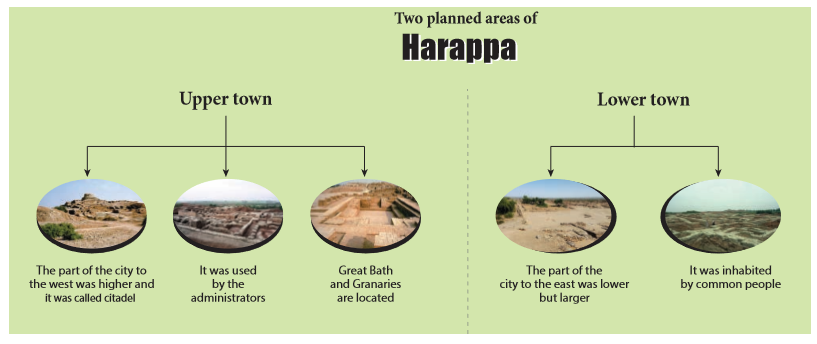Indus Civilisation Notes 6th Social Science
Indus Civilisation Notes 6th Social Science
6th Social Science Lesson 3 Notes in English
3. Indus Civilisation
1. Various Civilisation of the World:
- Mesopotomia – 3500-2000 BCE
- Indus valley – 3300-1900 BCE
- Egyptian – 3100-1100 BCE
- Chinese – 1700-1122 BCE
2. How Civilisation developed?
Initially, people lived in groups. Then they formed communities out of these groups. Then evolved the societies which in due course become civilizations.
3. Why did people settle near rivers?
People preferred to settle near the rivers for the reasons given below.
- The soil is fertile.
- Fresh water is available for drinking, watering livestock and irrigation.
- Easy movement of people and goods is possible.
4. How and by whom was Harappa discovered?
The ruins of Harappa were first described by the British East India Company soldier and explorer Charles Masson in his book. When he visited the North-West Frontier Province which is now in Pakistan, he came across some mysterious brick mounds. He wrote that he saw a “ruined brick castle with very high walls and towers built on a hill”.
5. In which year the Bricks from Harappa was taken?
In 1856 when engineers laid a railway line connecting Lahore to Karachi, they discovered more burnt bricks. Without understanding their significance, they used the bricks for laying the rail road.
6. When was excavation begun in Indus Valley?
In the 1920s archaeologists began to excavate the cities of Harappa and Mohenjo Daro. They unearthed the remains of these long-forgotten cities.
7. Who was the first to discover Harappa?
In 1924 the Director General of ASI, Sir John Marshall, found many common features between Harappa and Mohenjo-Daro. He concluded that they were part of a large civilisation.
6th Social Book Back Questions
8. Why Harappa was older than Mohenjodaro?
Some slight differences are found in the earthenwares of Harappa and Mohenjo-Daro. This made the researchers conclude that Harappa was older than Mohenjo-Daro.
9. The Archaeological Survey of India (ASI) was started in 1861 with Alexander Cunningham as Surveyor. Its headquarters is located in New Delhi.
10. How do archaeologists explore a lost city?
- Archaeologists study the physical objects such as bricks, stones or bits of broken pottery (sherds) to ascertain the location of the city and time that it belong to.
- They search the ancient literary sources for references about the place.
- They look at aerial photographs of the excavation sites or cities to understand the topography.
- To see under the ground, they may use a magnetic scanner
- The presence and absence of archeological remains can be detected by RADAR and Remote Sensing Methods.
11. Major Sites within in India.

12. Time Span of Indus Civilisation:
- Geographical range: South Asia
- Period: Bronze Age
- Time: 3300 to1900 BCE (determined using the radiocarbon dating method)
- Area: 13 lakh sq.km
- Cities: 6 big cities
- Villages: More than 200
13. Features of Urban Civilisation:
Harappan civilisation is said to be urban because of the following reasons.
- Well-conceived town planning
- Astonishing masonry and architecture
- Priority for hygiene and public health
- Standardised weights and measures
- Solid agricultural and artisanal base
14. Features of Harappan Civilisation:
Town planning is a unique feature of the Indus Civilisation. The Harappan city had two planned areas.
15. Define Mehergarh:
Mehergarh is a Neolithic site. It is located near the Bolan Basin of Balochistan in Pakistan. It is one of the earliest sites known. It shows evidence of farming and herding done by man in very early times. Archaeological evidence suggests that Neolithic culture existed in Mehergarh as early as 7000 BCE.
16. Show the Planned areas of Harappa:

17. Why burnt bricks are used in construction?
They are strong, hard, durable, resistant to fire and will not dissolve in water or rain.
18. Bronze Age It is a historical period characterised by the use of articles made of bronze
19. How the streets are arranged?
The streets are observed to have a grid pattern. They were straight running from north to south and east to west and intersected each other at right angles. The roads were wide with rounded corners.
20. Explain the house pattern in Indus valley?
Houses were built on both sides of the street. The houses were either one or two storeys. Most of the houses had many rooms, a courtyard and a well. Each house had toilets and bathrooms. The houses were built using baked bricks and mortar. Sun-dried bricks were also used. Most of the bricks were of uniform size. Roofs were flat. There is no conclusive evidence of the presence of palaces or places of worship.
21. Explain the Drainage system in Indus Valley:
Many of these cities had covered drains. The drains were covered with slabs or bricks. Each drain had a gentle slope so that water could flow. ¾ Holes were provided at regular intervals to clear the drains.
22. Describe the Structure of Great Bath:
- The great bath was a large, rectangular tank in a courtyard.
- It may be the earliest example of a water-proof structure.
- The bath was lined with bricks, coated with plaster and made water-tight using layers of natural bitumen.
- There were steps on the north and south leading into the tank. There were rooms on three sides.
- Water was drawn from the well located in the courtyard and drained out after use.
23. A granary with walls made of mud bricks, which are still in a good condition, has been discovered in Rakhigarhi, a village in Haryana, belonging to Mature Harappan Phase.
24. The Assembly Hall was another huge public building at Mohenjo-Daro. It was a multi-pillared hall (20 pillars in 4 rows to support the roof).
25. Explain Trade and Transport
Harappans were great traders. Standardised weights and measures were used by them. They used sticks with marks to measure length.
26. Trade Relationship with other Countries:
There is evidence for extensive maritime trade with Mesopotamia. Indus Seals have been found as far as Mesopotamia (Sumer) which are modern-day Iraq, Kuwait and parts of Syria.
King Naram-Sin of Akkadian Empire (Sumerian) has written about buying jewellery from the land of Melukha (a region of the Indus Valley).
Cylindrical seals similar to those found in Persian Gulf and Mesopotamia have also been found in the Indus area. This shows the trade links between these two areas.
27. Dockyard at Lothal: Lothal is situated on the banks of a tributary of Sabarmati river in Gujarat.
28. Describe the leader in Mohenjodoro
- A sculpture of a seated male has been unearthed in a building, with a head band on the forehead and a smaller ornament on the right upper arm.
- His hair is carefully combed, and beard finely trimmed.
- Two holes beneath the ears suggest that the head ornament might have been attached till the ear.
- The left shoulder is covered with a shawl-like garment decorated with designs of flowers and rings.
- This shawl pattern is used by people even today in those areas.
29. Technology Innovation in Indus Valley:
Indus people had developed a system of standardised weights and measures. Ivory scale found in Lothal in Gujarat is 1704mm (the smallest division ever recorded on a scale of other contemporary civilisations).
30. The word ‘civilisation’ comes from the ancient Latin word civis, which means ‘city’.
31. What did John Marshall told about Dancing Girl Statue:
“When I first saw them I found it difficult to believe that they were pre-historic modeling. Such as this was unknown in the ancient worlds up to the age of Greece. I thought that these figures had found their way into levels some 3000 years old to which they properly belonged”.
32. Define KVT Complex:
- KVT Complex (Korkai-Vanji-Thondi) spread over Afghanistan and Pakistan has many places, names of those were mentioned in sangam literature.
- Korkai, Vanji, Tondi, Matrai, Urai and Kudalgarh are the names of places in Pakistan.
- Gurkay and Pumpuhar in Afghanistan are related to the cities and ports mentioned in the Sangam Age.
- The names of the rivers Kawri and Poruns in Afghanistan and the rivers Kaweri Wala and Phornai in Pakistan also occur in the Sangam literature.
33. Who Governed them?
Historians believe that there existed a central authority that controlled planning of towns and overseas trade, maintenance of drainage and peace in the city.
34. What was their Occupation?
The main occupation of the Indus Civilisation people is not known. However, agriculture, handicrafts, pottery making, jewellery making, weaving, carpentry and trading were practiced. There were merchants, traders and artisans. Rearing of cattle was another occupation. People of those times knew how to use the potter’s wheel. they reared domesticated animals.
35. What Pottery was used by them?
Pottery was practiced using the potter’s wheel. It was well fired. Potteries were red in colour with beautiful designs in black. The broken pieces of pottery have animal figures and geometric designs on it.
36. What were their Religious Belief?
We don’t have any evidence pointing to specific deities or their religious practices. There might have been worship of Mother Goddess (which symbolized fertility), which is concluded based upon the excavation of several female figurines.
37. Archaeological site at Mohenjo-Daro has been declared as a World Heritage Site by UNESCO.
38. Radiocarbon Dating Method: A Standard Tool for Archaeologists Also known as C14 method, the radiocarbon method uses the radioactive isotope of carbon called carbon14 to determine the age of an object.
39. The earliest form of writing was developed by Sumerians.
40. What happened to Harappans?
By 1900 BCE, the Harappan culture had started declining. It is assumed that the civilisation met with
- repeated floods
- ecological changes
- invasions
- natural calamity
- climatic changes
- deforestation
- an epidemic
41. What were the Toys used by them?
Toys like carts, cows with movable heads and limbs, clay balls, tiny doll, a small clay monkey, terracotta squirrels eating a nut, clay dogs and male dancer have been found. They made various types of toys using terracotta, which show that they enjoyed playing.
42. What are Inscriptions?
Inscriptions (written in a script of those times) can provide us information about customs, practices and other aspects of any place or time. So far, the Indus script has not been deciphered. Therefore, we must look for other clues to know about the Indus people and their lifestyle
43. Iron was unknown to people of Indus.
44. Indus people used the red quartz stone called Carnelian to design jewellery.
45. Copper was the first metal discovered and used by humans.
46. What are Apparel?
Cotton fabrics were in common use. Clay spindles unearthed suggest that yarn was spun. Wool was also used.
47. What are the Ornaments used by them?
Ornaments were popular among men and women. They adorned themselves with necklaces, armlets, bangles, finger rings, ear studs and anklets. The ornaments were made of gold, silver, ivory, shell, copper, terracotta and precious stones.
48. Love and peace of Indus Valley:
Settlements were built on giant platforms and elevated grounds. The Indus Civilisation seems to have been a peaceful one. Few weapons were found and there is no evidence of an army. They displayed their status with garments and precious jewellery. They had an advanced civic sense.